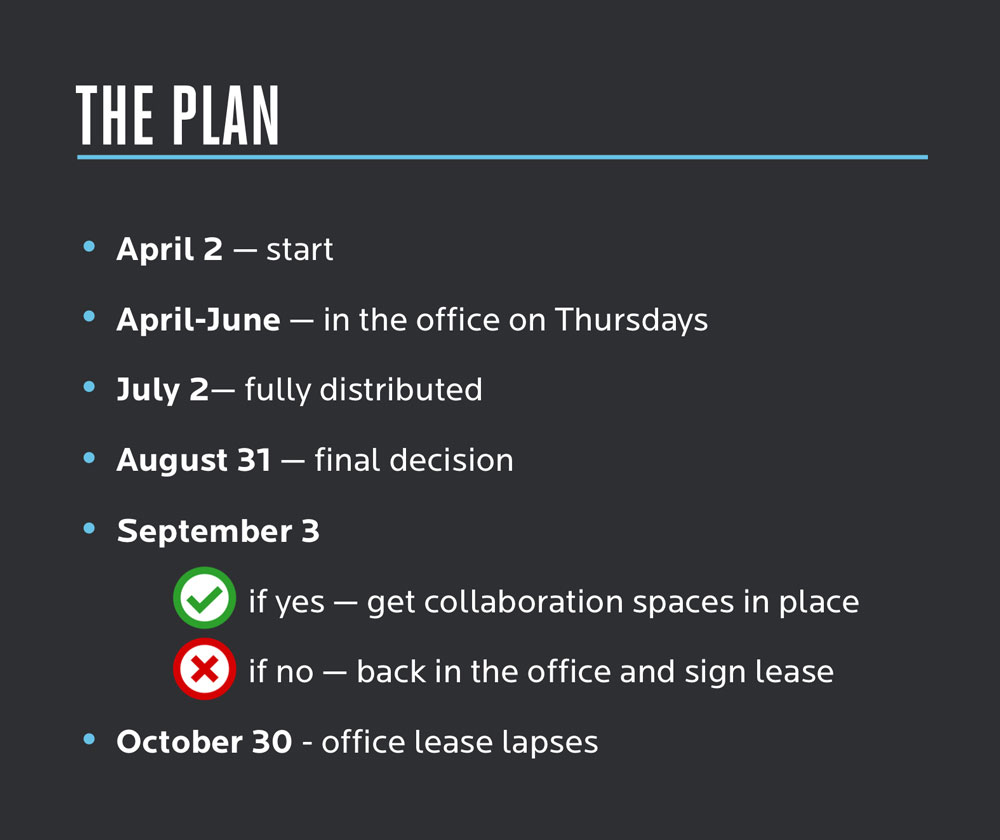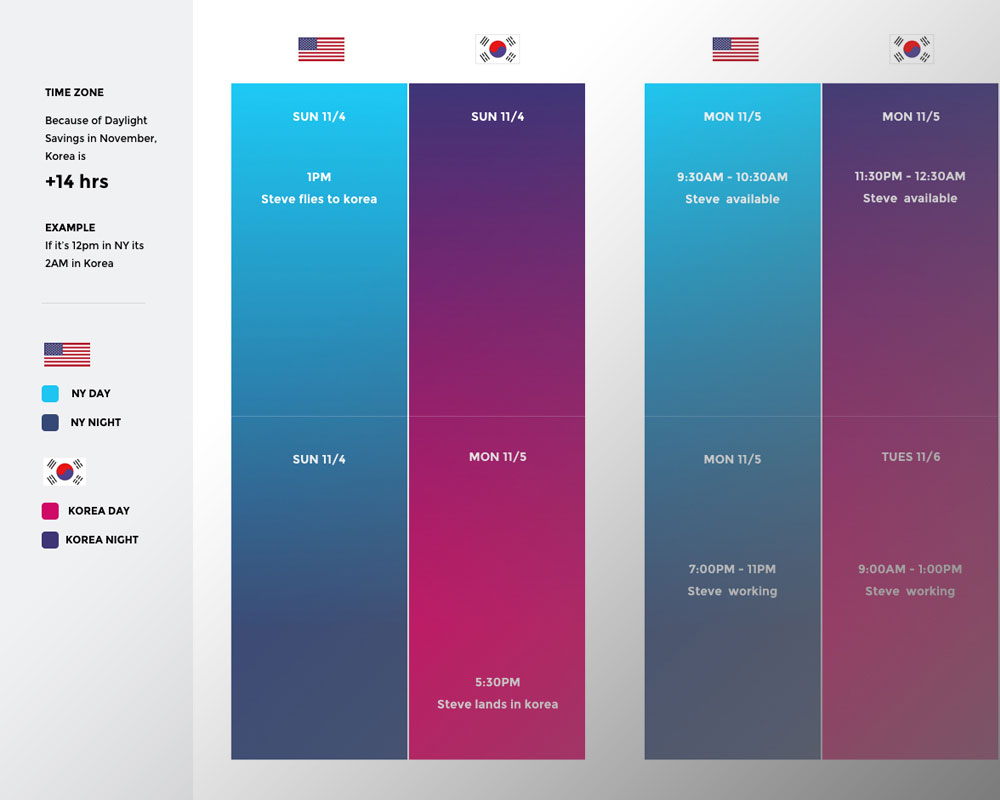Going Distributed: How, Why, and Tips for Success

Update: Over the last few years, ETR has learned a lot more about how to be successful as a distributed team. We’ve compiled these insights in a related article aimed at helping other organizations better cope with the remote work challenges posed by COVID-19.
Each year in Q1, ExpandTheRoom (ETR) has a senior offsite meeting. This allows us to step aside from running the business for a few days, so we can work on the business. During this annual meeting, we critique our previous year and do our best to plan the next. It was here, with a beautiful Colorado view in every direction, that the idea for “going distributed” first surfaced.
After much healthy discussion, we concluded that the distributed model made a lot of sense for ETR. We decided on an approach that would allow us to experiment with the concept rather than going cold-turkey. We wanted to test ourselves, and the business, to confirm this made sense for ETR before we committed fully. We created a plan that encouraged feedback and debate from team members and clients alike.
As anticipated, when we delivered this news to the team, there were lots of questions. What will happen to our culture? What will our clients think? When are we doing this? Where will we have meetings, etc? We addressed each item thoroughly and openly. Over the course of the session, we watched the surprised faces start to warm up to the idea and, ultimately, most folks ended up excited about the potential.
Here is the plan we shared with the team. We announced this in early March, so everyone had roughly 3 weeks notice.

In short, this was a calculated process to ensure that working as a distributed company was a good fit for ETR. The first three months of the experiment called for everyone to work from the office on Thursdays. Having one day a week together provided a good touchpoint to acknowledge what was and wasn’t working and conceive solutions where needed. After that, for another two months, there was no commitment to the office, but it was still available for anyone to use as needed.
After a successful test, we made the final decision to move forward on August 31st. This gave us another two months to make sure everything was running smoothly before our office lease lapsed.
The remainder of this article speaks a bit to the process we drove and our learnings.
The main reasons we decided to explore the distributed work model:
- We believe this is the future of work for many companies. It won’t work for everyone, but it may for us; we should at least explore it.
- Lifting the self-imposed geo-fence on NYC allows us to hire the best people for our team, no matter where they live.
- If this works for ETR, it should result in us being more efficient and less drained.
- The timing is right. The tools have evolved (we love us some Zoom, Slack, and Asana), clients are open to it, our internal process is mature and works, and the MTA seems to be getting worse/more painful every day.
- Our team members’ values are shifting. Many are starting families and considering living somewhere besides NYC.
- It’s a better engagement model for our clients. With clients all over the world, having a single space in NYC doesn’t make the most sense. We’d rather spend our ‘rent dollars’ traveling to clients’ offices and collaborating with them face-to-face.
Eleven Tips for Success:
- Regular, full-team check-ins are helpful. We do a 9:30 AM Monday morning, full-team standup and also eat lunch together (video) on Thursdays.
- Establish a morning routine, and do it every day. Note: rolling out of bed and into your desk chair is not a good morning routine.
- If you are working from home, get outside of your home often. Find real people and talk to them. Anyone who stays in one room too long gets weird.
- Reliable headphones/mics and fast internet are well worth the money. Spend the time needed to make sure your remote/home setup works.
- Establish and follow video conferencing best practices. If you are looking for some, you may find this helpful.
- When looking for places to work, fast, reliable connectivity is key, of course, but don’t underestimate your work environment. Find a few different local places that work so you have options ready to go if one is not working for you on any given day. Our team has found great value in Croissant and Spacious and, of course, traditional co-working spaces like WeWork can be a great option for many.
- If you are considering going distributed, you probably have a great company culture. Porting that culture over to distributed is difficult and proved impossible for us. Force yourself, as we did, to reinvent your culture for this new chapter.
- If you are traveling out of town to client meetings — go in the night before to help mitigate travel risk and fatigue. Also, recognize that different team members have different levels of travel comfort/anxiety. I learned first-hand that not everyone is comfortable booking same-day travel, but if you are, HotelTonight can be quite helpful.
- International travel is tough on anyone. Be honest with yourself about how productive you’re going to be the 2-3 days on either side of a trip. If there is a large time difference, clearly plan out your working day and educate your team — it’s unacceptable to let your team down due to your travel schedule or location.
- If work is as much a social activity for you as it is a job, you’ll want to look for other social outlets to help replace the bits that will be lost from not going to an office every day.
- Get together often, in-person, as a team.

Admittedly, we’re early into this game but we’re already seeing a lot of benefits. Healthier, commute-less employees who have more time for their families. It’s easier to get heads-down and focus, which ultimately makes us a more efficient and productive team. Flexibility for our employees to travel (during the experiment we had traditionally NYC-based team members working from Tennessee, Washington, North Carolina, China, and Korea). We believe travel makes people richer and broadens their perspectives, which ultimately benefits the work and our clients.
This whole experience has brought our team even closer together in a lot of ways. It’s also been great for our clients, who have enjoyed the productivity lift and our commitment to getting in the same room with them whenever it makes sense.
One more big win, it will be more convenient for us all to vote next week. Register here if you haven’t already.
Of course, there are challenges, there always are. Candidly, here are a few we still wrestle with:
Occasionally, more conservative clients need a little warming up to the idea (understandably so), but it only takes one experience with us to convert them.
It’s a pretty hairy day when someone’s internet drops or Slack or Asana fumbles — however, the reality is that these days are few and far between and were just as disruptive when we were all in the same office.
Often there’s no replacement for facetime (old-school not Apple’s) — we need to continue to acknowledge when we need to be in the same room and make it happen.
Consistent process is your friend — as we discover inconsistencies in our process, we firm them up along the way. We’ve created our Purpose-Driven Design Toolkit to help with this (internal today, but we hope to release it publicly in the future).
Hiring is even more critical. You need to make sure you are hiring the right people and onboard them thoroughly. On that note, we’re hiring.
Are you thinking about going distributed? Drop us a line if we can give you any more insights. Have you already gone distributed? What are some of your big takeaways? Need a little Purpose-Driven Design in your life? Hit us up.
I publish this today, October 30, 2018, the last day of our traditional NYC commercial lease. And for the record, I’m working from Bonaire right now.
